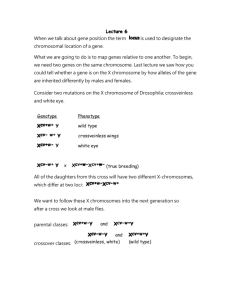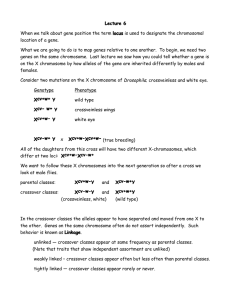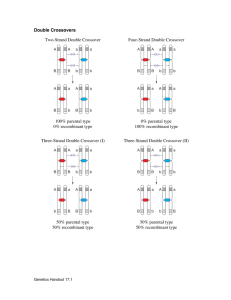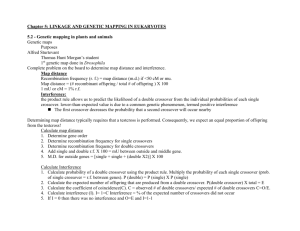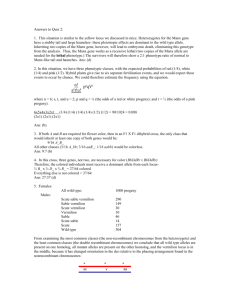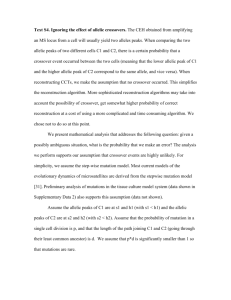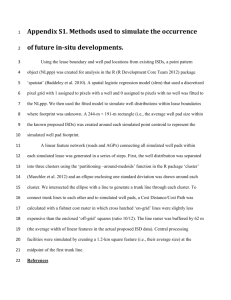S2 Appendix - Simulation of recombination events.
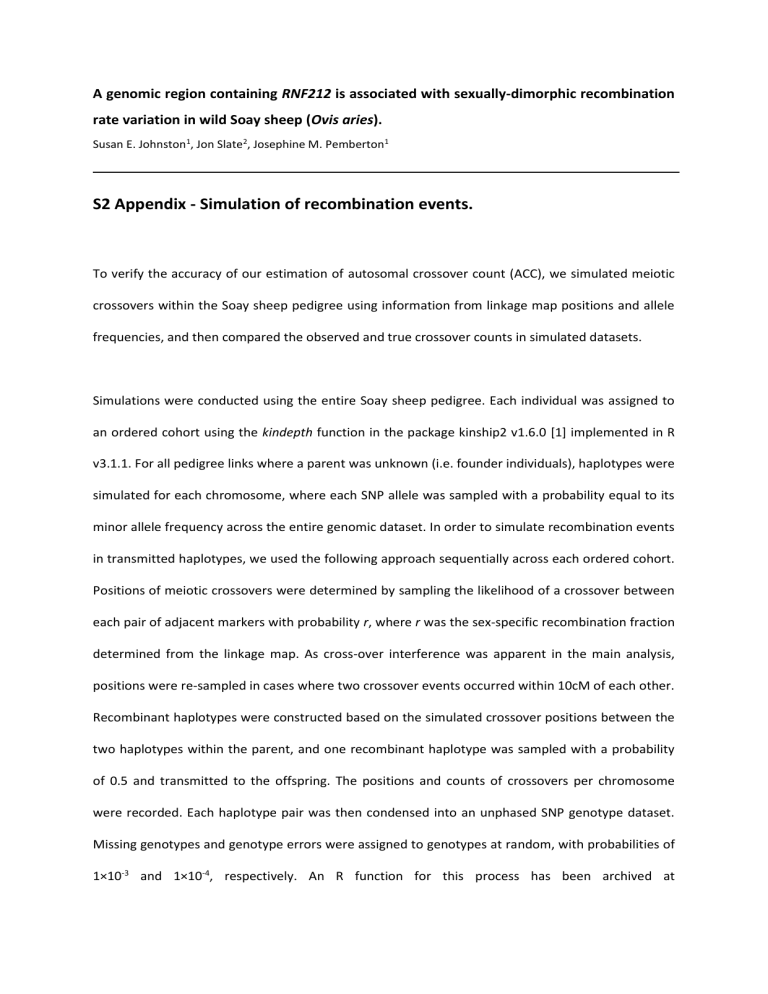
A genomic region containing RNF212 is associated with sexually-dimorphic recombination rate variation in wild Soay sheep (Ovis aries).
Susan E. Johnston 1 , Jon Slate 2 , Josephine M. Pemberton 1
S2 Appendix - Simulation of recombination events.
To verify the accuracy of our estimation of autosomal crossover count (ACC), we simulated meiotic crossovers within the Soay sheep pedigree using information from linkage map positions and allele frequencies, and then compared the observed and true crossover counts in simulated datasets.
Simulations were conducted using the entire Soay sheep pedigree. Each individual was assigned to an ordered cohort using the kindepth function in the package kinship2 v1.6.0 [1] implemented in R v3.1.1. For all pedigree links where a parent was unknown (i.e. founder individuals), haplotypes were simulated for each chromosome, where each SNP allele was sampled with a probability equal to its minor allele frequency across the entire genomic dataset. In order to simulate recombination events in transmitted haplotypes, we used the following approach sequentially across each ordered cohort.
Positions of meiotic crossovers were determined by sampling the likelihood of a crossover between each pair of adjacent markers with probability r, where r was the sex-specific recombination fraction determined from the linkage map. As cross-over interference was apparent in the main analysis, positions were re-sampled in cases where two crossover events occurred within 10cM of each other.
Recombinant haplotypes were constructed based on the simulated crossover positions between the two haplotypes within the parent, and one recombinant haplotype was sampled with a probability of 0.5 and transmitted to the offspring. The positions and counts of crossovers per chromosome were recorded. Each haplotype pair was then condensed into an unphased SNP genotype dataset.
Missing genotypes and genotype errors were assigned to genotypes at random, with probabilities of
1×10 -3 and 1×10 -4 , respectively. An R function for this process has been archived at
http://github.com/susjoh/simperSNP. Individual ACCs were then calculated in FIDs in each simulated dataset as using the same analysis outlined in the methods section "Estimation of meiotic crossovers".
Our approach was highly accurate in identifying the true simulated crossover count across all individuals (linear regression of observed counts as a function of true simulated counts, 𝑏̅ = 1.014 ±
1.51 × 10 -3 (s.d.), mean adjusted r 2 = 0.991 ± 6.7 × 10 -4 ). The per-individual correlations across all simulations were also high ( 𝑏̅ = 0.992 ± 0.013, mean adjusted r 2 = 0.99 ± 0.011). A general linear model of per individual mean adjusted r 2 was fitted, including sex and genomic inbreeding coefficient 𝐹̂ as fixed effects. Adjusted r 2 values and slopes were significantly higher in females than in males (P < 0.001, Table S9, Figure S5); This may be due to increased crossover rates in males resulting in some crossovers not being identified; the removal of single SNP runs may also have more acute effects at telomeric regions of chromosomes, where crossovers may be more likely to occur in males. Adjusted R 2 values and slopes were also negatively correlated with the genomic inbreeding coefficient 𝐹̂ (P < 0.001, Table S9, Figure S5), which may be due to an increased chance of runs of homozygous genotypes, meaning that substantial regions of the genome cannot be assigned to a particular grandparent of origin. Double crossovers occurring within such regions are therefore less likely to be identified. In both cases, slopes are lower than 1, indicating that crossover counts are consistently under-estimated, albeit to a small degree, in males and/or in more inbred individuals
(Table S9).
1. Therneau T, Atkinson E, Sinnwell J, Schaid D, McDonnell S. kinship2 v1.6.0. 2014.
Table S9. General linear model of the individual correlations and slopes of detected vs. simulated ACC per individual over 100 simulations.
Value
Adjusted r 2
Slope
Effect
Female (Intercept)
Male
𝐹̂
Female (Intercept)
Male
𝐹̂
Estimate
0.994
-0.015
-0.147
0.9953
-0.011
-0.123
S.E.
1.8×10 -04
2.9×10 -04
6.0×10 -03
2.6×10 -04
4.4×10 -04
8.9×10 -03 t
5536
-49.66
-24.39
3768.8
-25.35
-13.83
P
<0.001
<0.001
<0.001
<0.001
<0.001
<0.001

